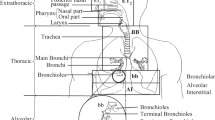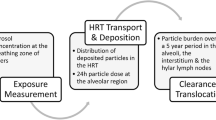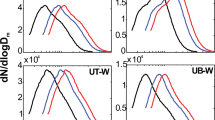Abstract
The ExDoM is a model for calculating the human exposure and the deposition, dose, clearance, and finally retention of aerosol particles in the respiratory tract at specific times during and after exposure, under variable exposure conditions. Specifically, the model incorporates an exposure module which allows the user to set variable or static exposure conditions (exposure concentration, physical exertion levels, and different environments) or in the case of the physical exertion levels and exposure environment to choose from a list of typical exposure scenarios (activity pattern, exposure environment, and physical exertion level). The exposure concentration can refer to total particulate matter (PM) concentration or chemically resolved particles of variant size distributions. The aerosol size parameters can be introduced to the model either directly as median aerodynamic diameter and geometric standard deviation or are estimated by the model from measurement data. The model treats monodisperse or polydisperse aerosol size distributions. The human respiratory tract (RT) model of the International Commission on Radiological protection (ICRP Publication 66) is utilized for the respiratory tract deposition calculations. The above together with the dose and clearance/retention modules can be used to study together exposure and dose of chemically resolved particles of variant size distributions. The ExDoM model implementation in order to study the exposure and dose of particles in the human RT is demonstrated at two locations. In particular, the dose and retention of particles to RT and the mass transferred to the gastrointestinal tract and blood capillaries are estimated for an adult Caucasian male exposed to PM10 at a coastal remote site in the eastern Mediterranean. In addition, the regional lung doses of specific chemical components of PM10 (inorganic ions and carbonaceous compounds) during realistic exposure conditions outdoors at a residential background area in Oslo, Norway, were assessed. The results from the two studies showed that the dose was enhanced for the carbonaceous fine fraction of particles in the alveolar region of the lung whereas the dose of crustal material dominated in the extrathoracic region.







Similar content being viewed by others
References
Aleksandropoulou V (2004) Study on the deposition and translocation of particulate matter in the human respiratory tract (case studies). Dissertation, Technical University of Crete (In Greek)
Aleksandropoulou V, Mitsakou C, Housiadas C, Lazaridis M (2008) Particulate matter exposure and dose relationships derived from realistic exposure scenarios. Indoor Built Environ 17:237–246
Bailey MR, Ansoborlo E, Guilmette RA, Paquel F (2003) Practical application of the ICRP human respiratory tract model. Radiat Prot Dosim 105(1–4):71–76
Bailey MR, Ansoborlo E, Guilmette RA, Paquel F (2007) Updating the ICRP human respiratory tract model. Radiat Prot Dosim 127(1–4):31–34
Bolch WE, Huston TE, Farfan EB, Vernetson WG, WEm B (2003) Influences of parameter uncertainties within the ICRP-66 respiratory tract model: particle clearance. Health Phys 84(4):421–435
Brown JS (2005) Particle inhalability at low wind speeds. Inhal Toxicol 17(14):831–837
Chan TL, Lippmann M (1980) Experimental measurements and empirical modelling of the regional deposition of inhaled particles in humans. Am Ind Hyg Assoc J 41:399–409
Cross ES, Slowik JG, Davidovits P, Allan JD, Worsnop DR, Jayne JT, Lewis DK, Canagaratna M, Onasch TB (2007) Laboratory and ambient particle density determinations using light scattering in conjunction with aerosol mass spectrometry. Aerosol Sci Technol 41(4):343–359
Dab W, Segala C, Dor F, Festy B, Lameloise P, Le Moellec Y, Le Tertre A, Medina S, Quenel P, Wallaert B, Zmirou D (2001) Air pollution and health: correlation or causality? The case of the relationship between exposure to particles and cardiopulmonary mortality. J Air Waste Manage Assoc 51:220–235
Darquenne C, Paiva M (1994) One-dimensional simulation of aerosol transport and deposition in the human lung. J Appl Physiol 77:2889–2898
Dockery DW, Pope CA, Xu X, Spengler JD, Ware JH, Fay ME, Ferris BG, Speizer FE (1993) An association between air pollution and mortality in six U. S. Cities. N Engl J Med 329:1753–1808
Georgopoulos PG (2008) A multiscale approach for assessing the interactions of environmental and biological systems in a holistic health risk assessment framework. Water Air Soil Pollut Focus 8:3–21
Georgopoulos PG, Lioy PJ (2006) From a theoretical framework of human exposure and dose assessment to computational system implementation: the modelling and environment for total risk studies (MENTOR). J Toxicol Environ Health B 9:457–483
Gradon L, Podgorski A (1999) Deposition and retention of fine and ultrafine particles in the pulmonary region of human lungs. Normal and pathological cases. J Aerosol Sci 30:S801–S802
Hansen JE, Ampaya EP (1975) Human air space shapes, sizes, areas, and volumes. J Appl Physiol 38(6):990–995
Hinds WC (1999) Aerosol technology: properties, behaviour and measurement of airborne particles. Wiley, New York
International Commission on Radiological Protection (ICRP) (1994) Human Respiratory Tract Model for Radiological Protection. ICRP Publication 66. Pergamon Press, Oxford
Kalivitis N, Birmili W, Stock M, Wehner B, Massling A, Wiedensohler A, Gerasopoulos E, Mihalopoulos N (2008) Particle size distributions in the Eastern Mediterranean troposphere. Atmos Chem Phys 8:6729–6738
Karanasiou A, Eleftheriadis K, Vratolis S, Zaebas P, Mihalopoulos N, Mitsakou C, Housiadas C, Lazaridis M, Ondracek J, Dzumbova L (2008) Size distribution of inorganic species and their inhaled dose in a detergent industrial workplace. Water Air Soil Pollut Focus 8:71–76
Katsouyanni K, Touloumi G, Spix C, Schwartz J, Balducci F, Medina S, Rossi G, Wojtyniak B, Sunyer J, Bacharova L, Schouten JP, Ponka A, Anderson HR (1995) Short term effects of ambient sulphur dioxide and particulate matter on mortality in 12 European cities: results from time series data from the APHEA project. Br Med J 314:1658–1663
Katsouyanni K, Touloumi G, Samoli E, Gryparis A, Le Tatre A, Monopolis Y, Rossi G, Zmirou D, Ballester F, Boumghar A, Anderson H, Wojtyniak B, Paldy A, Barunstein R, Pekkanen J, Schnidler C, Schwartz J (2001) Confounding effect modification in the short-term effects of ambient particles on total mortality: results from 29 European cities within the APHEA 2 project. Epidemiology 12(5):521–531
Koblinger L, Hofmann W (1990) Monte Carlo modeling of aerosol deposition in human lungs. Part I: simulation of particle transport in a stochastic lung structure. J Aerosol Sci 21:661–674
Kousa A, Kukkonen J, Karrppinen A, Aarnio P, Koskentalo T (2002) A model for evaluating the population exposure to ambient air pollution in an urban area. Atmos Environ 36:2109–2119
Krewski D, Burnett RT, Goldberg MS, Hoover K, Siemiatycki J, Jerrett M, Abrahamowicz M, White WH et al (2000) Reanalysis of the Harvard Six Cities Study and the American Cancer Society Study of Particulate Air Pollution and Mortality. Health Effects Institute. http://pubs.healtheffects.org/view.php?id=6. Accessed 11 November 2010
Lazaridis M, Broday D, Hov O, Georgopoulos PG (2001) Integrated exposure and dose modeling and analysis system. 3. Deposition of inhaled particles in the human respiratory tract. Environ Sci Technol 35:3727–3734
Lazaridis M, Dahlin E, Hansen JE, Smolik J, Schmidbauer N, Moravec P, Zdimal V, Hermansen O, Glytsos T, Svendby T, Dye C (2003) Indoor/outdoor particulate matter measurements in two residential houses in Oslo, Norway. J Aerosol Sci 34(S2):1367–1368
Lazaridis M, Spyridaki A, Smolik J, Zdimal V, Eleftheriadis K, Aleksandropoulou V, Hov O, Georgopoulos PG (2005) Mesoscale modeling of combined aerosol and photo-oxidant processes in the Eastern Mediterranean. Atmos Chem Phys 5:927–940
Lazaridis M, Aleksandropoulou V, Smolik J, Hansen JE, Glytsos T, Kalogerakis N, Dahlin E (2006) Physico-chemical characterization of indoor/outdoor particulate matter in two residential houses in Oslo, Norway: measurements overview and physical properties. Indoor Air 16:282–295
Lazaridis M, Aleksandropoulou V, Hansen JE, Dye C, Eleftheriadis K, Katsivela E (2008) Inorganic and carbonaceous components in indoor/outdoor particulate matter in two residential houses in Oslo, Norway. J Air Waste Manage Assoc 58(3):346–356
Martonen TB, Zhang Z (1993) Deposition of sulfate acid aerosols in the developing human lung. Inhal Toxicol 5:165–187
Ménache MG, Miller FJ, Raabe OG (1995) Particle inhalability curves for humans and small laboratory animals. Ann Occup Hyg 39:317–328
Mihalopoulos N, Stephanou E, Kanakidou M, Pilitsidis S, Bosquet P (1997) Tropospheric aerosol ionic composition in the Eastern Mediterranean region. Tellus B Chem Phys Meteorol 49:314–326
Nixon W, Egan MJ (1987) Modelling study of regional deposition of inhaled aerosols with special reference to effects of ventilation asymmetry. J Aerosol Sci 18:563–579
NUREG (2002) Proceedings of the Environmental Software Systems Compatibility and Linkage Workshop. U.S. Nuclear Regulatory Commission. Rockville, Maryland. NUREG/CP-0177, PNNL-13654. http://www.nrc.gov/reading-rm/doc-collections/nuregs/conference/cp0177/0177.pdf. Accessed 11 November 2010
Phalen RF, Oldham MJ, Beaucage CB, Crocker TT, Mortensen JD (1985) Postnatal enlargement of human tracheo-bronchial airways and implications for particle deposition. Anat Rec 212(4):368–380
Pope CA, Dockery D (2006) Health effects of fine particulate air pollution: lines that connect. J Air Waste Manage Assoc 56:709–742
Pope C, Hill R, Villegas G (1999) Particulate air pollution and daily mortality on Utah’s Wasatch Front. Environ Health Perspect 107:567–573
Pope CA, Burnett RT, Thun MJ, Calle EE, Krewski D, Ito K, Thurston GD (2002) Lung cancer, cardiopulmonary mortality, and long-term exposure to fine particulate air pollution. JAMA 287:1132–1141
Price OT, Asgharian B, Miller FJ, Cassee FR, Winter-Sorkina R (2002) Multiple Path Particle Dosimetry model (MPPD v1.0): A model for human and rat airway particle dosimetry. RIVM rapport 650010030. RIVM, Bilthoven, The Netherlands
Price PS, Chaisson CF, Koontz M, Wilkes C, Ryan B, Macintosh D, Georgopoulos PG (2003) Construction of a Comprehensive Chemical Exposure Framework Using Person Oriented Modeling. Prepared by The Lifeline Group for The Exposure Technical Implementation Panel, American Chemistry Council. Contract Number 1338. http://www.thelifelinegroup.org/LifeLine/Documents/comprehensive_chemical_exposure_framework.pdf. Accessed 11 November 2010
Ramachandran G, Vincent JH (1997) Evaluation of two inversion techniques for retrieving health-related aerosol fractions from personal cascade impactor measurements. Am Ind Hyg Assoc J 58:15–22
Rudolf G, Gebhart J, Heyder J, Schiller ChF, Stahlhofen W (1986) An empirical formula describing aerosol deposition in man for any particle size. J Aerosol Sci 17:350–355
Russell AG, Brunekreef B (2009) A focus on particulate matter and health. Environ Sci Technol 43(13):4620–4625
Salma I, Balashazy I, Winkler-Heil R, Hofmann W, Zaray G (2002) Effect of particle mass size distribution on the deposition of aerosols in the human respiratory system. J Aerosol Sci 33:119–132
Salvi S, Holgate T (1999) Mechanisms of particulate matter toxicity. Clin Exp Allergy 29:1187–1194
Sasso AF, Isukapalli SS, Georgopoulos PG (2010) A generalized physiologically-based toxicokinetic modeling system for chemical mixtures containing metals. Theor Biol Med Model 7:article number 17
Schwartz J, Norris G, Larson T, Sheppard L, Claiborne C, Koenig J (1999) Episodes of high coarse particle concentrations are not associated with increased mortality. Environ Health Perspect 107:339–342
Smith JRH, Bailey MR, Etherington G, Shutt AL, Youngman MJ (2007) Further study of the effect of particle size on slow particle clearance from the bronchial tree. Radiat Prot Dosim 127(1–4):35–39
Smolik J, Zdimal V, Schwarz J, Lazaridis M, Havranek V, Eleftheriadis K, Mihalopoulos N, Bryant C, Colbeck I (2003) Size resolved mass concentration and elemental composition of atmospheric aerosols over the eastern Mediterranean area. Atmos Chem Phys 3:2207–2216
Stahlhofen W, Gebhart J, Heyder J (1980) Experimental determination of the regional deposition of aerosol particles in the human respiratory tract. Am Ind Hyg Assoc J 41:385–398
Sturm R (2007) A computer model for the clearance of insoluble particles from the tracheobronchial tree of the human lung. Comput Biol Med 37:680–690
Sturm R, Hofmann W (2006) A multi-compartment model for slow bronchial clearance of insoluble particles—extension of the ICRP human respiratory tract models. Radiat Prot Dosim 118(4):384–394
Turpin BJ, Lim HJ (2001) Species contributions to PM2.5 mass concentrations: revisiting common assumptions for estimating organic mass. Aerosol Sci Technol 35(1):602–610
US EPA (1999) Total Risk Integrated Methodology, TRIM.expo.: Technical Support Document. US EPA Office of Air Quality Planning and Standards. Office of Air and Radiation. Research Triangle Park, NC. EPA-453/D-99-001
US EPA (2003) A Framework for a Computational Toxicology Research Program in ORD. US EPA Office of Research and Development, Washington DC. EPA/600/R-03/065
US EPA (2004a) Air Quality Criteria for Particulate Matter. Research Triangle Park, NC. EPA/600/P-99/002aD
US EPA (2004b) Report on the Model SHEDS-MENTOR-1A. US EPA Council for Regulatory Environmental Modeling (CREM), Washington DC. http://cfpub.epa.gov/crem/crem_report.cfm?deid=75917
US EPA (2004c) Report on the Model SHEDS-MENTOR-4M. US EPA Council for Regulatory Environmental Modeling (CREM). Washington DC. http://cfpub.epa.gov/crem/crem_report.cfm?deid=75918
Vincent JH, Mark D (1982) Application of Blunt sampler theory for the definition and measurement of inhalable dust. Ann Occup Hyg 26(1–4):3–19
Weibel ER (1963) The normal human lung. Academic, New York
WHO (2006) World Health Organisation Air Quality Guidelines, Global Update 2005. http://www.euro.who.int/__data/assets/pdf_file/0005/78638/E90038.pdf. Accessed 11 November 2010
Wolfenbarger JK, Seinfeld JK (1990) Inversion of aerosol size distribution data. J Aerosol Sci 21:227–247
Yeh HC, Schum GM (1980) Models of human lung airways and their application to inhaled particle deposition. Bull Math Biol 42:461–480
Yu CP, Diu CK (1982) A comparative study of aerosol deposition in different lung models. Am Ind Hyg Assoc J 43:54–65
Yu CP, Diu CK (1983) Total and regional deposition of inhaled aerosols in humans. J Aerosol Sci 5:599–609
Zhang Q, Canagaratna MR, Jayne JT, Worsnop DR, Jimenez JL (2005) Time and size-resolved chemical composition of submicron particles in Pittsburg-Implications for aerosol sources and processes. J Geophys Res D: Atmos 110:D07S09
Acknowledgments
This work was supported by the Research Committee of Technical University of Crete under Basic Research grant 2006. The measurements at Oslo were performed in the framework of the European Commission project URBAN-AEROSOL (grant EVK4-CT-2000-00018) and the measurements at Finokalia in the framework of the European Commission project SUB-AERO (grant EVK2-CT-1999-00052).
Author information
Authors and Affiliations
Corresponding author
Rights and permissions
About this article
Cite this article
Aleksandropoulou, V., Lazaridis, M. Development and application of a model (ExDoM) for calculating the respiratory tract dose and retention of particles under variable exposure conditions. Air Qual Atmos Health 6, 13–26 (2013). https://doi.org/10.1007/s11869-010-0126-z
Received:
Accepted:
Published:
Issue Date:
DOI: https://doi.org/10.1007/s11869-010-0126-z




